
1 DEBT COLLECTION RULE: DISCLOSING THE VALIDATION INFORMATION VERSION 1.0 (10/2021)
ITEMIZATION TABLE
1700 G Street NW, Washington, DC 20552
Debt Collection Rule: Disclosing the Model
Validation Notice Itemization Table
October 29, 2021
This is a Compliance Aid issued by the Consumer Financial Protection Bureau. The Bureau published a Policy
Statement on Compliance Aids, available at
https://www.consumerfinance.gov/policy-compliance/rulemaking/final-
rules/policy-statement-compliance-aids/, that explains the Bureau’s approach to Compliance Aids.
1
An editable version of the model validation notice is available here.
1
The Debt Collection Rule (Rule) requires debt collectors to provide consumers with certain
information to help them identify the debt being collected. This information is called the
“validation information” and consists of information about the debt, information about the
consumer’s protections and rights during collection of the debt, and information to facilitate the
consumer’s ability to exercise those rights. The Rule details how a debt collector can provide the
validation information in a validation notice.
Appendix B of the Rule sets forth a model validation notice that a debt collector has the option to
use to provide the validation information. A debt collector is not required to use the model
validation notice. However, a debt collector who uses the model validation notice obtains a safe
harbor for the content and format requirements related to the validation information.
1
12 CFR
1006.34(d)(2); see also 12 CFR 1006.34(c) and 34(d)(1).
A debt collector also has the option to use a version of the model validation notice that adds or
omits certain optional content, a version that includes certain content on a separate page, or a
version that is otherwise substantially similar to the model validation notice. A debt collector who

2 DEBT COLLECTION RULE: DISCLOSING THE VALIDATION INFORMATION VERSION 1.0 (10/2021)
ITEMIZATION TABLE
uses one of these options also obtains a safe harbor for the content and format requirements
related to the validation information, except with respect to any content that appears on a separate
page. 12 CFR 1006.34(d)(2); see also 12 CFR 1006.34(c) and 34(d)(1).
However, because use of the model validation notice is not required, a debt collector also has the
option to provide the validation information using a form that is not substantially similar to the
model validation notice. Such a validation notice must still provide all of the required validation
information, and a debt collector who uses such a notice does not receive a safe harbor for the
content and format requirements of the Rule for the validation information provided. 12
CFR 1006.34(d)(2); see also 12 CFR 1006.34(c) and 34(d)(1).
2
This guidance document addresses how to provide certain validation information. This document
assumes use of the model validation notice.
3
Specifically, the Rule requires debt collectors to
include on the validation notice both the current amount of the debt and certain information about
the debt as of a particular date called the “itemization date.” Most of this required information
appears on the model validation notice in a tabular format.
Because this document assumes use of the model validation notice, it also assumes this
information will be disclosed in the tabular format. This document refers to that table as the
“Itemization Table” when providing guidance on the included disclosures. However, the concepts
discussed also apply more generally even if the model validation notice is not used.
2
More information about the validation information content and format requirements can be found in Section 12 of the
Debt Collection Rule Small Entity Compliance Guide
. Additionally, more information about the option to use the
model validation notice and how changes to the model validation notice affect the safe harbor for the validation
information content and format requirements can be found in the
Debt Collection Rule FAQs, Validation Information
Questions 2 through 4, as well as Section 12.1.3 of the Debt Collection Rule Small Entity Compliance Guide.
3
That is, this guidance document assumes a debt collector will use the model validation notice as it appears in
Appendix B of the Rule. This generally assumes that, among other things, a debt collector will not disclose certain
Itemization Table information on a separate page or use, for residential mortgage debt, the ability to substitute the
most recent periodic statement for some Itemization Table information (i.e., follow the special rule for residential
mortgage debt, or “Special Rule”). 12 CFR 1006.34(d)(2)(ii). As noted, a debt collector who uses either such option
retains the safe harbor for content and format requirements when using the model validation notice, except with
respect to content appearing on the separate page. However, some of the guidance discussed below may not apply, or
may apply differently, in such cases. For more information on the ability to disclose certain Itemization Table
information on a separate page, see footnote 8, below. For more information on the special rule for residential
mortgage debt, see footnotes 4 and 7, below and the
Debt Collection Rule FAQs, Validation Information: Residential
Mortgage Debt Questions.

3 DEBT COLLECTION RULE: DISCLOSING THE VALIDATION INFORMATION VERSION 1.0 (10/2021)
ITEMIZATION TABLE
This guidance document first provides an overview of the validation information contained in the
Itemization Table. It then illustrates steps a debt collector may take to complete the Itemization
Table. It also provides examples showing how a debt collector might complete the Itemization
Table for different types of debts.
Overview of the Itemization Table
Among other things, the validation notice generally
4
must include the following information about
the debt:
1. An itemization date. This is a reference date that occurs on or before the date the
validation notice is sent and on which the debt collector can ascertain the amount of the
debt. The itemization date is designed to reflect an event in the debt’s history that
consumers may recognize. The itemization date must be one of the following reference
dates: 1) the date of the last statement (generally from a creditor); 2) the charge-off date; 3)
the last payment date; 4) the transaction date; or 5) the judgment date. 12 CFR
1006.34(b)(3); 1006.34(c)(2)(vi).
2. The amount of the debt as of that itemization date. 12 CFR 1006.34(c)(2)(vii).
3. An itemization of the current amount of the debt that discloses categories of information
since the itemization date: 1) interest, 2) fees, 3) payments, and 4) credits. This guidance
document refers to these categories as the “Itemized Amounts.” Fields for the Itemized
Amounts must be included in the itemization, and the amounts cannot be left blank, even if
no additional amounts have been assessed or applied during the relevant time period. If
no additional amounts have been assessed or applied, a debt collector may include a zero
or “none,” or may state that no interest, fees, payments, or credits have been assessed or
applied to the debt. 12 CFR 1006.34(c)(2)(viii).
4. The current amount of the debt as of the date that the validation information is provided.
12 CFR 1006.34(c)(2)(ix).
4
Note that, if a debt collector uses the special rule for certain residential mortgage debt, discussed in footnote 3 above,
certain information, including the itemization date, is not required to be disclosed on the validation notice. However,
a debt collector must still determine the itemization date to disclose the other itemization-date dependent validation
information. See Debt Collection Rule FAQs, Validation Information: Residential Mortgage Debt Questions 2 and 5
.
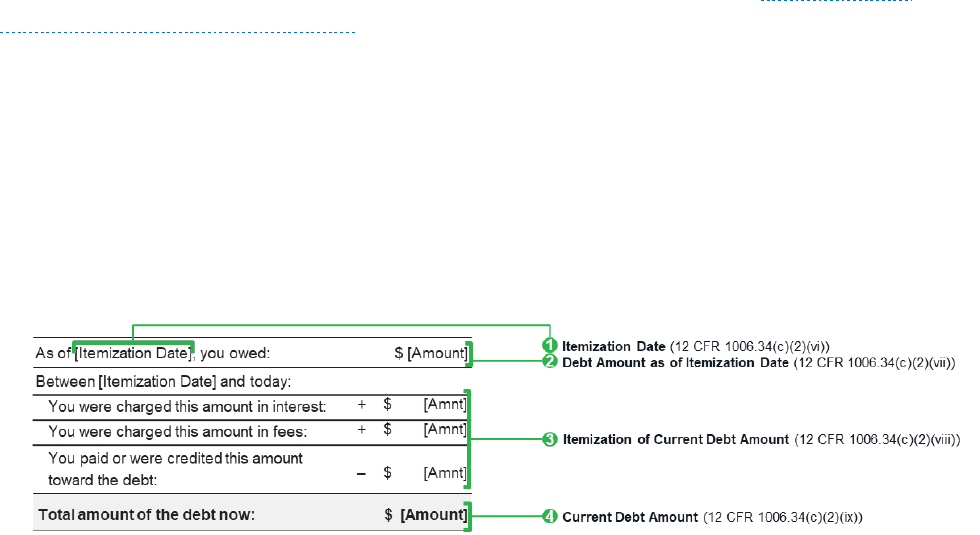
4 DEBT COLLECTION RULE: DISCLOSING THE VALIDATION INFORMATION VERSION 1.0 (10/2021)
ITEMIZATION TABLE
These validation information requirements are discussed in more detail in the Debt Collection
Rule Small Entity Compliance Guide.
Generally, this validation information is required. A debt collector violates the Rule if any
required validation information is not disclosed to the consumer.
Figure 1 provides an annotated version of the Itemization Table showing where this information is
disclosed on the model validation notice.
FIGURE 1: ANNOTATED MODEL VALIDATION NOTICE ITEMIZATION TABLE
One way a debt collector using the model validation notice may, but is not required to, complete
the Itemization Table to disclose this information is to use the following four steps:
1. Select the itemization date;
2. Determine the amount of the debt as of the itemization date;
3. Determine the Itemized Amounts since the itemization date; and
4. Determine the current amount of the debt.
These steps are discussed in more detail below.
Steps to Complete the Itemization Table
Step 1: Select the itemization date
Generally, a debt collector will begin the process of completing the Itemization Table by selecting
the itemization date for the debt. Although the Rule does not require a debt collector to start with
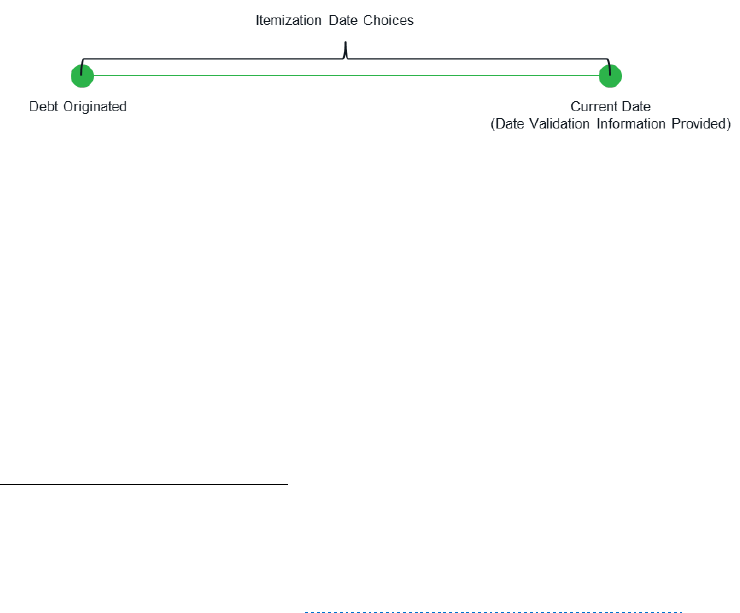
5 DEBT COLLECTION RULE: DISCLOSING THE VALIDATION INFORMATION VERSION 1.0 (10/2021)
ITEMIZATION TABLE
this step, a debt collector likely will need to do so because two of the other three components of the
Itemization Table (i.e., the debt amount as of the itemization date and the itemization of the
current debt amount) and other validation information outside the Itemization Table
5
are directly
tied to the itemization date.
To select the itemization date for the Itemization Table, a debt collector must select one of the
following reference dates: 1) the last creditor statement date; 2) the charge-off date; 3) the last
payment date; 4) the transaction date; or 5) the judgment date. These events may occur at any
point in the history of the debt, and are not necessarily close to the date the validation information
is provided. Depending on the facts and circumstances, a debt may or may not have all five
reference dates. 12 CFR 1006.34(b)(3); 1006.34(c)(2)(vi).
FIGURE 2: TIME PERIOD DURING WHICH THE ITEMIZATION DATE MAY OCCUR
6
Once a debt collector uses an itemization date in a communication providing the itemization
information to the consumer, the debt collector must consistently use that date when a required
disclosure for that consumer is based on the itemization date. For example, if a debt collector uses
the last statement date to determine and disclose the amount of the debt as of the itemization date
(Step 2), the debt collector may not use the charge-off date to itemize the current amount of the
debt in the validation notice (Step 4). Comment 1006.34(b)(3)-1. However, a subsequent debt
5
For example, a debt collector is required to disclose the account number, if any, as of the itemization date and the
creditor information as of the itemization date, if applicable, although this information is not included in the
Itemization Table. 12 CFR 1006.34(c)(2)(iii) and 34(c)(2)(iv). More information about this validation information
can be found in Section 12.1.1 of the Debt Collection Small Entity Compliance Guide
.
6
Depending on which reference date the debt collector selects, the itemization date may fall anywhere between the
origination date and the date the validation information is provided. For ease of reference, the remaining illustrations
in this guidance document assume the itemization date occurs roughly midway between origination and the date the
validation notice is provided.

6 DEBT COLLECTION RULE: DISCLOSING THE VALIDATION INFORMATION VERSION 1.0 (10/2021)
ITEMIZATION TABLE
collector need not use the same itemization date as a prior debt collector. Comment
1006.34(b)(3)-2.
Details about the reference dates that may serve as the itemization date are discussed below.
LAST STATEMENT DATE
The last statement date is the date of the last written account statement, invoice, or periodic
statement (including, but not limited to, any statements required by law) provided to the
consumer by a creditor. 12 CFR 1006.34(b)(3)(i). A debt collector who selects the last
statement date as the itemization date must identify the date of the last written statement or
invoice provided to the consumer by a creditor.
For purposes of determining the itemization date, a statement qualifies as the last statement
only if it was provided by the creditor or a third party acting on the creditor’s behalf, such as a
creditor’s service provider. A statement or invoice provided by a debt collector is not a last
statement for purposes of the itemization date disclosed in the Itemization Table, unless the
debt collector is also a creditor.
7
Comment 1006.34(b)(3)(i)-1. For example, assume a
mortgage servicer is also a “debt collector” under the Rule. Assume also that this debt collector
may, but chooses not to, use the special rule for certain residential mortgage debt, and instead
discloses the Itemization Table in the validation notice. Under these circumstances, if the debt
collector selects the last statement date as the itemization date, the debt collector would need to
determine the date of the last statement provided by a creditor (or a prior mortgage servicer
acting on the creditor’s behalf that was not also a “debt collector” under the Rule). The debt
collector could not use the date of a periodic statement that it or any other debt collector
provided to the consumer, unless that debt collector was also a creditor.
Common statement types that may be the last statement provided to the consumer by a creditor
include periodic billing statements, a written statement provided on behalf of a creditor during
7
Note, however, if a debt collector chooses to use the special rule for certain residential mortgages, discussed in
footnotes 3 and 4 above, to disclose the itemization date-dependent information when providing the validation notice,
the debt collector uses the date of the most recent periodic statement. That periodic statement may be one that the
debt collector (or a previous debt collector) provided the consumer, even if the debt collector (or a previous debt
collector) is not a creditor. For more information on the special rule for certain residential mortgage debt, see the
Debt Collection Rule FAQs, Validation Information: Residential Mortgage Debt Questions
.
7 DEBT COLLECTION RULE: DISCLOSING THE VALIDATION INFORMATION VERSION 1.0 (10/2021)
ITEMIZATION TABLE
default judgment proceedings, or a final invoice from the creditor. 12 CFR 1006.34(b)(3)(i);
1006.34(c)(5).
CHARGE-OFF DATE
The charge-off date is the date the debt was charged off. 12 CFR 1006.34(b)(3)(ii). The Rule
does not limit the charge-off date to a charge off made by the creditor. For example, for
residential mortgage loans, the charge-off date may be the date that either the creditor or
servicer of the mortgage loan charged off the debt. 12 CFR 1006.34(b)(3)(ii).
LAST PAYMENT DATE
The last payment date is the date the last payment was applied to the debt. 12 CFR
1006.34(b)(3)(iii). If selecting the last payment date as the itemization date, the debt collector
must identify the last payment applied to the account and use that date.
The Rule does not limit the last payment only to payments that count as periodic payments or
full payments under the terms of the contract. The last payment used to identify the last
payment date therefore may be a periodic payment, or it may be a non-periodic payment, a
partial payment, or a non-conforming payment. For example, a payment the consumer made
as part of loss mitigation or as an attempt to reinstate the account may be the last payment for
purposes of determining the last payment date.
The last payment used to identify the last payment date need not be from the consumer. The
last payment may also be one made by a third party. For example, the last payment may be a
payment from an auto repossession agent, such as auction proceeds, that was applied to the
debt, or it may be a payment from an insurance company that was applied to the debt, so long
as those were the last payments on the account. Comment 1006.34(b)(3)(iii)-1. Other
examples of last payments made by third parties may include the application of the proceeds
from a real estate sale to the account.
The Rule does not limit the last payment only to payments applied to the account by a creditor.
For example, payments applied by a debt collector or third-party payment processor may count.
TRANSACTION DATE
The transaction date is the date of the transaction that gave rise to the debt, i.e., the date that
the good or service that gave rise to the debt was provided or made available to the consumer.
12 CFR 1006.34(b)(3)(iv); Comment 1006.34(b)(3)(iv)-1. For example, the transaction date for
a debt arising from a medical procedure may be the date the medical procedure was performed,
8 DEBT COLLECTION RULE: DISCLOSING THE VALIDATION INFORMATION VERSION 1.0 (10/2021)
ITEMIZATION TABLE
and the transaction date for a consumer’s gym membership may be the date the membership
contract was executed. Comment 1006.34(b)(3)(iv)-1. For a residential mortgage, the
transaction date may be the date the mortgage was originated, but is not, for example, the date
of a mortgage servicing transfer.
In some cases, a debt may have more than one transaction date. If a debt has more than one
transaction date, a debt collector may use any of those dates as the transaction date for
purposes of the itemization date. For example, if a consumer enters into a contract on one date
and the creditor performs the contracted service on another date, the debt collector may select
either date as the transaction date. Comment 1006.34(b)(3)(iv)-1.
Additionally, for some debts, not only are there separate dates for the agreement to provide
services and the provision of those services, but those services may be provided on multiple
days. For example, for a medical debt where multiple procedures giving rise to the debt were
provided by the same creditor, depending on the facts and circumstances, a debt collector may
select any of the dates the procedures were performed as the transaction date.
If a debt has multiple transaction dates, whichever date the debt collector selects must be used
consistently in the validation notice. Comment 1006.34(b)(3)(iv)-1.
JUDGMENT DATE
The judgment date is the date of any final court judgment that determines the amount of the
debt owed by the consumer. 12 CFR 1006.34(b)(3)(v). In the case of a final judgment renewal,
depending on the facts and circumstances, the final judgment renewal may be the judgment
date.
Once a debt collector selects the itemization date for the debt, the debt collector can then
determine the other components of the Itemization Table.
Step 2: Determine the amount of the debt as of the itemization date
Using the itemization date selected under Step 1, the debt collector next determines the amount of
the debt as of the itemization date. 12 CFR 1006.34(c)(2)(vii). For example, depending on the
facts and circumstances, the amount of the debt as of the itemization date may be the amount of
the debt that is required to bring the account current as of that date or the total outstanding debt
as of that date.
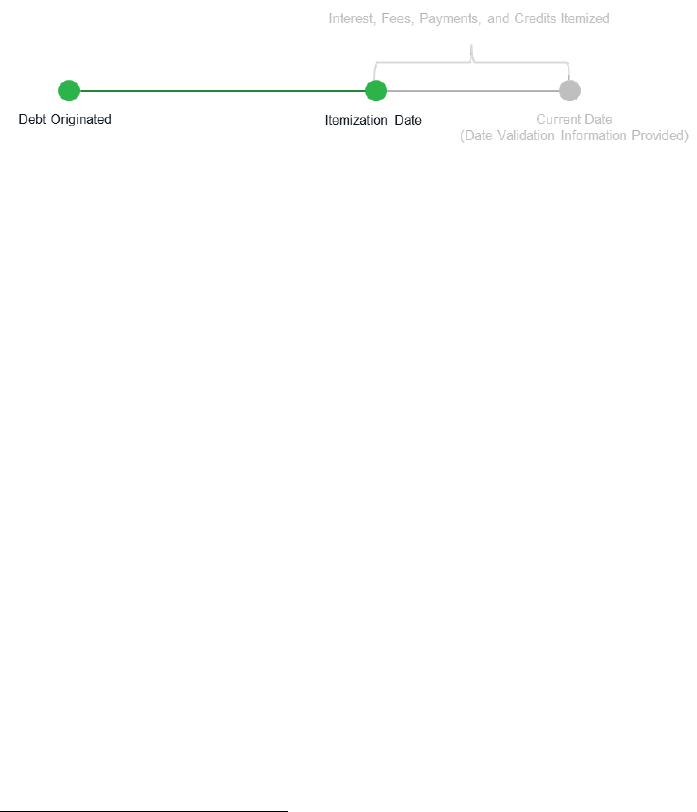
9 DEBT COLLECTION RULE: DISCLOSING THE VALIDATION INFORMATION VERSION 1.0 (10/2021)
ITEMIZATION TABLE
The amount must include any interest, fees, or other charges owed, less any payments or credits
applied, by the itemization date. Comment 1006.34(c)(2)(vii)-1.
FIGURE 3: TIME PERIOD ILLUSTRATION FOR THE DEBT AMOUNT AS OF THE ITEMIZATION DATE
Figure 3 illustrates the relevant time period for amount of the debt as of the itemization date. For
example, if a debt collector is using the transaction date as the itemization date and selects the
latest of multiple permissible dates, then any amounts applied to the account as of that date are
reflected in this disclosure determined in Step 2.
The amount is disclosed in the first row of the Itemization Table.
Step 3: Determine the Itemized Amounts since the itemization date
8
Next, a debt collector itemizes the current amount of the debt, disclosing any interest, fees,
payments, and credits (the Itemized Amounts) between the itemization date and the date the
validation information is provided. 12 CFR 1006.34(c)(2)(viii); Comment 1006.34(c)(2)(ix)-1. For
ease of reference, this guidance document refers to the time period between the itemization date
and the date the validation information is provided as the “Itemization Period.”
8
Even if using the model validation notice, a debt collector is permitted under the Rule to provide the Itemized
Amounts discussed in Step 3 on a separate page(s) instead of in the Itemization Table. If the debt collector does so,
however, the debt collector must include the separate page(s) in the same communication with the validation notice
and include on the validation notice, where the itemization information would have appeared, a statement referring to
that separate page(s). 12 CFR 1006.34(c)(2)(viii); Comment 1006.34(c)(2)(viii)-3. Note that the information
provided on the separate page does not receive the safe harbor for the validation information content and format
requirements. 12 CFR 1006.34(d)(2); see also 12 CFR 1006.34(c) and 34(d)(1).

10 DEBT COLLECTION RULE: DISCLOSING THE VALIDATION INFORMATION VERSION 1.0 (10/2021)
ITEMIZATION TABLE
FIGURE 4: ITEMIZATION PERIOD ILLUSTRATION
The Rule does not define interest, fees, payments, or credits for purposes of determining the
Itemized Amounts. As such, the Rule does not specify a particular accrual method that debt
collectors must use to calculate interest, but the disclosed interest amount must be accurate. For
example, depending on the facts and circumstances, a debt collector may use the interest accrual
method (e.g., monthly, simple interest, average daily balance method) in any underlying debt
agreement, or may use a method that is otherwise customarily used for the debt.
The Rule requires disclosure of any Itemized Amounts applied to the account during the
Itemization Period, regardless of the source. For example, a third-party payment or insurance
adjustment may be disclosed either as a “payment” or a “credit” in the itemization.
9
An interest, fee, payment, or credit amount applied to the account during the Itemization Period,
but that is returned or reversed during that same period, may be omitted from the Itemization
Table. For example, a payment made during the Itemization Period that was also returned during
the Itemization Period may be omitted from the Itemized Amounts, provided that the payment
and the return offset each other, and the other amounts are disclosed accurately.
There may be circumstances in which an amount cannot be accurately categorized as interest or a
fee, payment, or credit. In such a case, a debt collector who accurately itemizes only the interest,
fees, payments, and credits complies with the Rule even if there are amounts included in the
“current amount of the debt” disclosure (Step 4) that are not included in the itemization of the
debt.
10
The Rule does not require that the amount of the debt as of the itemization date, plus or
9
Note that, in the Itemization Table, these two fields are disclosed as a single amount.
10
A debt collector could choose to add a field to the itemization for amounts that cannot accurately be characterized as
an Itemized Amount, as long as the amount is accurately described and not combined with the Itemized Amounts.

11 DEBT COLLECTION RULE: DISCLOSING THE VALIDATION INFORMATION VERSION 1.0 (10/2021)
ITEMIZATION TABLE
minus the Itemized Amounts, equal the “current amount of the debt,” even if the debt collector
uses the Itemization Table. For example, if the creditor provided another service to the consumer
during the Itemization Period, the debt collector may, depending on the facts and circumstances,
not need to disclose that service charge amount in the Itemized Amounts. However, if the service
charge is part of the debt being collected, the debt collector must still include the amount in the
“current amount of the debt” (Step 4).
If no additional amounts have accrued since the itemization date, a debt collector may include a
“0” or “none,” or may state that no interest, fees, payments, or credits have been assessed or
applied to the debt. Comment 1006.34(c)(2)(viii)-1.
Step 4: Determine the current debt amount
Finally, the debt collector must disclose the amount of the debt as of when the validation
information is provided. 12 CFR 1006.34(c)(2)(ix). This amount includes the amount of the debt
as of the itemization date from Step 2, as well as the Itemized Amounts from Step 3, and, if
applicable, any amounts from the Itemization Period that could not be accurately categorized as an
Itemized Amount (i.e., as interest or a fee, payment, or credit).
FIGURE 5: TIME PERIOD ILLUSTRATION FOR THE CURRENT AMOUNT OF THE DEBT
For example, depending on the facts and circumstances, the current amount of the debt may be
the amount of the debt that is required to bring the account current as of when the validation
information is provided or the total outstanding debt when the validation information is provided.
The Rule does state that, for residential mortgage debt subject to the periodic statement
However, if the validation notice with the added information is not substantially similar to the model validation
notice, then the safe harbor does not apply with respect to the entirety of the validation notice. For more discussion
on the safe harbor and making changes to the model validation notice, see the
Debt Collection Rule FAQs, Validation
Information Questions 2 through 4.

12 DEBT COLLECTION RULE: DISCLOSING THE VALIDATION INFORMATION VERSION 1.0 (10/2021)
ITEMIZATION TABLE
requirements under Regulation Z, the debt collector may provide the current amount of the debt
by providing the consumer the total balance of the outstanding mortgage, including principal,
interest, fees, and other charges. Comment 1006.34(c)(2)(ix)-1.
Example Itemization Tables
Each of the examples below describes the collection of one type of debt and illustrates how a debt
collector could complete the Itemization Table assuming the facts described in the example. The
examples are only illustrations of the concepts discussed above and are not necessarily the only
way to comply with the Rule. They are not meant to be examples of compliance with other rules.
Example 1: Credit card debt
For this debt, assume the following timeline of events:
March 21, 2011: The consumer opened a credit card with Ficus Bank, a creditor.
September 1, 2021: Ficus Bank applied the last payment made by the
consumer. After September 1
st
, no payments were received for, or applied to, the
account. The account went into default.
March 15, 2022: Ficus Bank provided the last monthly billing statement before
the account was charged off.
March 30, 2022: Ficus Bank charged off the debt. As of March 5
th
, including
pre-charge off interest and fees, the consumer owed $10,000.
April 15, 2022: Ficus Bank determined an amount of $100 the consumer
previously disputed was correctly charged and added the transaction back to the
debt.
May 1, 2022: Ficus Bank assigned the debt to ABC Financial, Inc., a debt
collector, for collection.
May 30, 2022: ABC Financial, Inc., provided the validation notice.
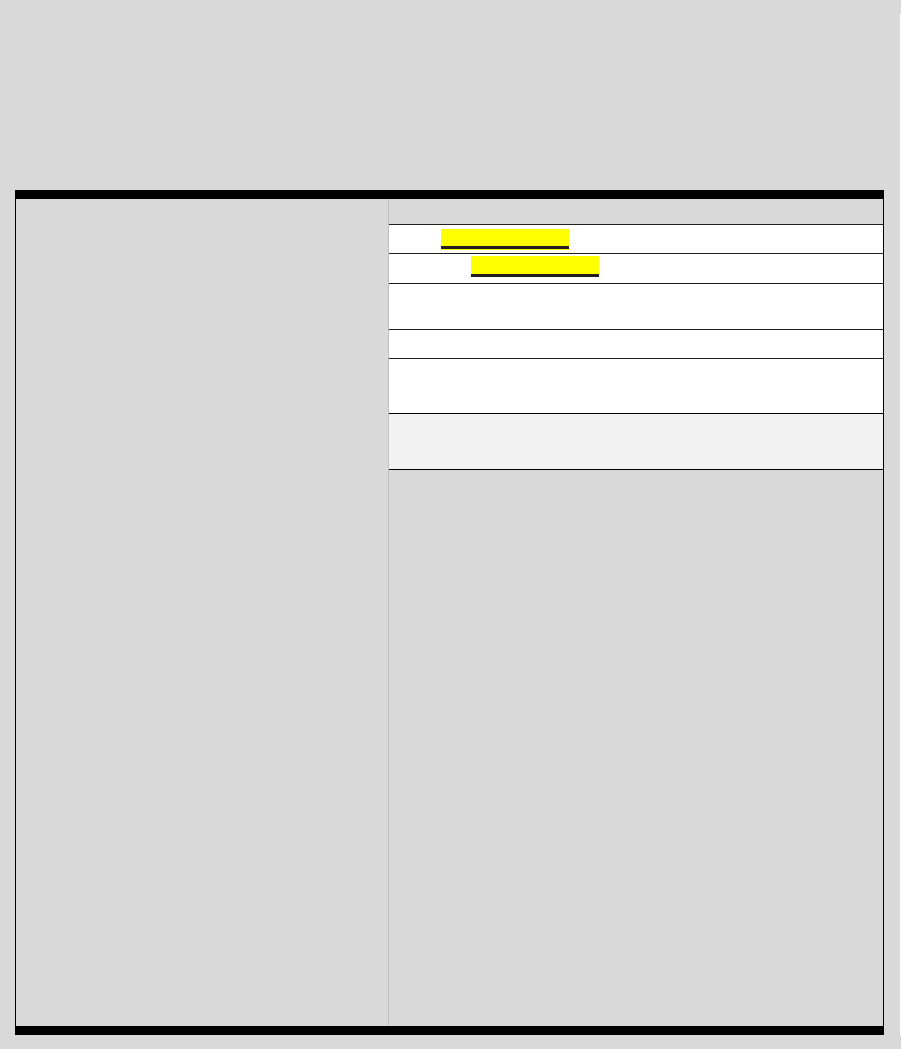
13 DEBT COLLECTION RULE: DISCLOSING THE VALIDATION INFORMATION VERSION 1.0 (10/2021)
ITEMIZATION TABLE
Also assume that, since the charge-off date (March 30, 2022), the account did not
accumulate any interest or fees.
Based on these facts, ABC Financial, Inc., could disclose the Itemization Table by
applying the four steps discussed above as follows:
Step 1: Select an itemization
date.
This example uses the charge-off
date (March 30, 2022).
Other available reference dates in
this example include:
Transaction date: March 21,
2011, the date the account was
opened.
Last payment date: September
1, 2021, the date the last
payment was applied to the
account.
Last statement date: March 15,
2022, the date of the last
statement sent by the creditor.
Note: In this example, there is no
judgment date.
As of March 30, 2022, you owed:
$
Between March 30, 2022 and today:
You were charged this amount in
interest:
+
$
You were charged this amount in fees: +
$
You paid or were credited this
amount toward the debt:
–
$
Total amount of the debt now:
$
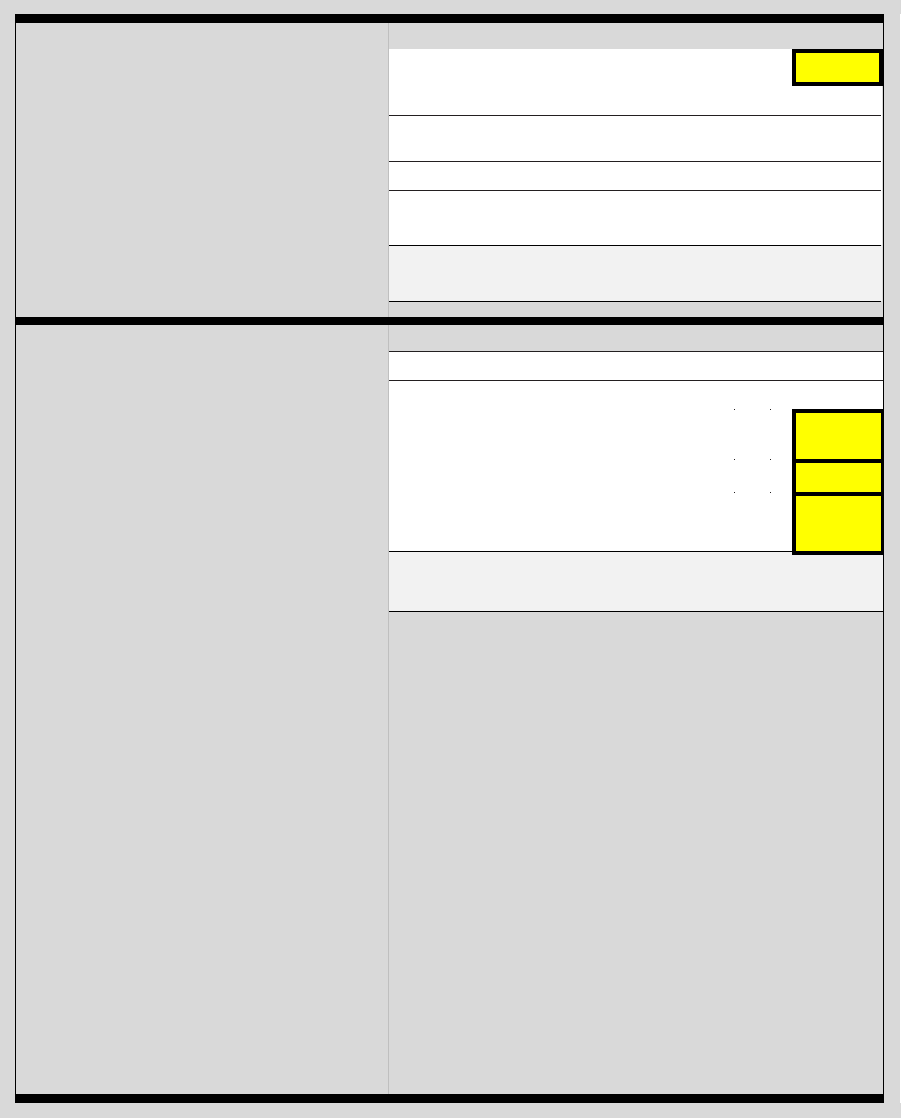
14 DEBT COLLECTION RULE: DISCLOSING THE VALIDATION INFORMATION VERSION 1.0 (10/2021)
ITEMIZATION TABLE
Step 2: Determine the amount
of the debt as of the
itemization date.
Enter the account balance as of the
itemization date selected in Step 1
(March 30, 2022).
As of March 30, 2022, you owed:
$
10,000.00
Between March 30, 2022 and today:
You were charged this amount in
interest:
+
$
You were charged this amount in fees: +
$
You paid or were credited this
amount toward the debt:
–
$
Total amount of the debt now:
$
Step 3: Determine the Itemized
Amounts since the itemization
date.
Enter the interest and fees charged,
as well as the payments and credits
applied, to the account during the
Itemization Period (i.e., between
the itemization date (March 30,
2022) and the date the validation
information is provided (May 30,
2022)).
Interest: No interest was
charged during the Itemization
Period. This field must still be
disclosed. In this example, the
field is disclosed as “0,” as
permitted by the Rule.
Fees: No fees were charged
during the Itemization Period.
This field must still be
disclosed. In this example, the
As of March 30, 2022, you owed:
$
10,000.00
Between March 30, 2022 and today:
You were charged this amount in
interest:
+
$
0
You were charged this amount in fees: +
$
0
You paid or were credited this
amount toward the debt:
–
$
0
Total amount of the debt now:
$
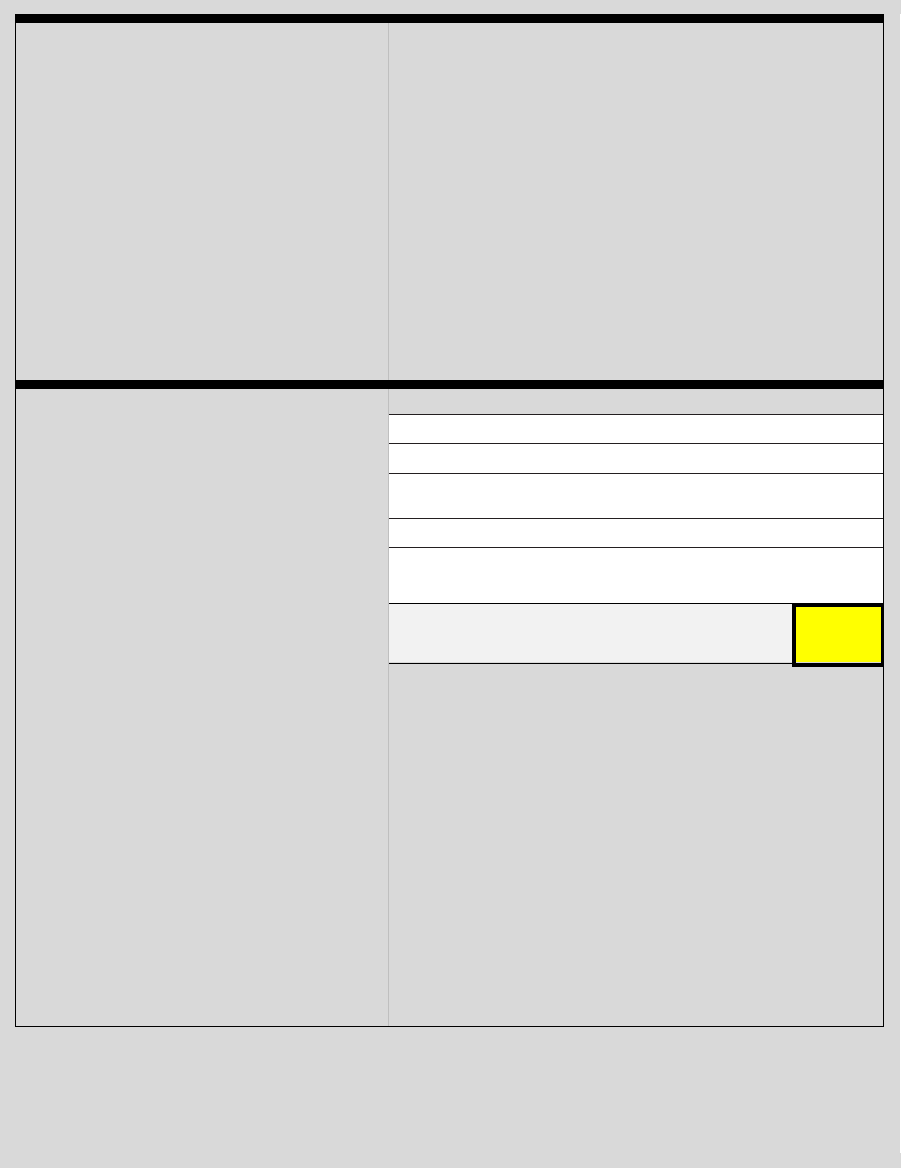
15 DEBT COLLECTION RULE: DISCLOSING THE VALIDATION INFORMATION VERSION 1.0 (10/2021)
ITEMIZATION TABLE
field is disclosed as “0,” as
permitted by the Rule.
Payments and Credits: No
payments were made and no
credits were applied during the
Itemization Period. This field
must still be disclosed. In this
example, the field is disclosed
as “0,” as permitted by the Rule.
Step 4: Determine the current
debt amount.
Enter the current account balance
as of the date the validation
information is provided (May 30,
2022).
Because of the circumstances, ABC
Financial, Inc., did not include the
post-dispute amount ($100) in the
Itemized Amounts. However, ABC
Financial, Inc., did include the
post-disputed amount in the
current amount of the debt.
This is the completed Itemization
Table ABC Financial, Inc., included
in the validation notice.
As of March 30, 2022, you owed:
$
10,000.00
Between March 30, 2022 and today:
You were charged this amount in
interest:
+
$
0
You were charged this amount in fees: +
$
0
You paid or were credited this
amount toward the debt:
–
$
0
Total amount of the debt now:
$
10,100.
00

16 DEBT COLLECTION RULE: DISCLOSING THE VALIDATION INFORMATION VERSION 1.0 (10/2021)
ITEMIZATION TABLE
Example 2: Residential mortgage debt
For this loan, assume the following timeline of events:
January 5, 2013: The consumer originated a $100,000 mortgage loan with
Ficus Bank.
February 2013 - January 2022: The consumer made mortgage payments as
due. During that time, Ficus Bank transferred servicing to Ficus Mortgage
Company, a mortgage servicer.
February 5, 2022: Ficus Mortgage Company applied a partial payment from the
consumer to the account. This was the last payment applied to the account. Ficus
Mortgage Company later determined the consumer was in default.
August 5, 2022: Ficus Mortgage Company sent its last Regulation Z-required
periodic statement to the consumer before servicing of the account was
transferred to another servicer. As of August 5
th
, the consumer’s account balance
was $75,234.56.
August 15, 2022: Ficus Mortgage Company transferred servicing of the
defaulted account to a different mortgage servicer, ABC Financial, Inc. ABC
Financial, Inc., is also a “debt collector” under the Rule.
September 5, 2022: ABC Financial, Inc., sent its first Regulation Z-required
periodic statement to the consumer.
September 6, 2022: ABC Financial, Inc., provided the validation notice.
Also assume that, since the date of the last statement provided by the creditor (August 5,
2022), the account accrued $260 in interest and $75 in fees (all permitted by the
underlying mortgage contract signed by the consumer). The fees were comprised of $25
in late fees and $50 in property inspection fees.
If ABC Financial, Inc., chooses to use the model validation notice, it has two options: 1) it
may fully complete the Itemization Table, or 2) it may use the special rule for certain
residential mortgages.
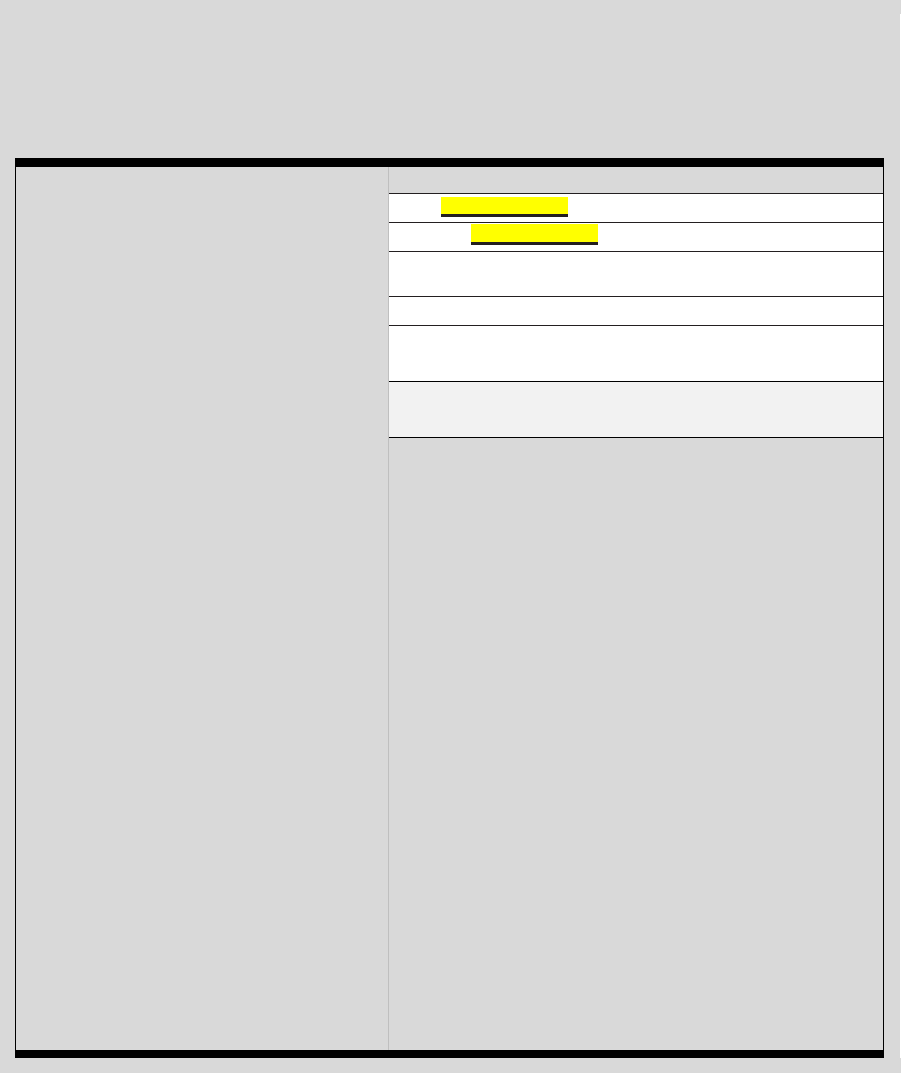
17 DEBT COLLECTION RULE: DISCLOSING THE VALIDATION INFORMATION VERSION 1.0 (10/2021)
ITEMIZATION TABLE
Option 1: Fully complete the Itemization Table
Based on these facts, ABC Financial, Inc., could disclose the Itemization Table by
applying the four steps discussed above as follows:
Step 1: Select an itemization
date.
This example uses the last
statement date (August 5, 2022).
Remember, the last statement date
is not September 5, 2022, the date
of the periodic statement sent by
ABC Financial, Inc. That statement
was provided by a debt collector
who was not also a creditor.
Other available reference dates in
this example include:
Transaction date: January 1,
2013, the date the mortgage
was originated.
Last payment date: February 5,
2022, the date the consumer’s
partial payment was applied to
the account.
Note: In this example, there is no charge-
off date or judgment date.
As of August 5, 2022, you owed:
$
Between August 5, 2022 and today:
You were charged this amount in
interest:
+
$
You were charged this amount in fees: +
$
You paid or were credited this
amount toward the debt:
–
$
Total amount of the debt now:
$
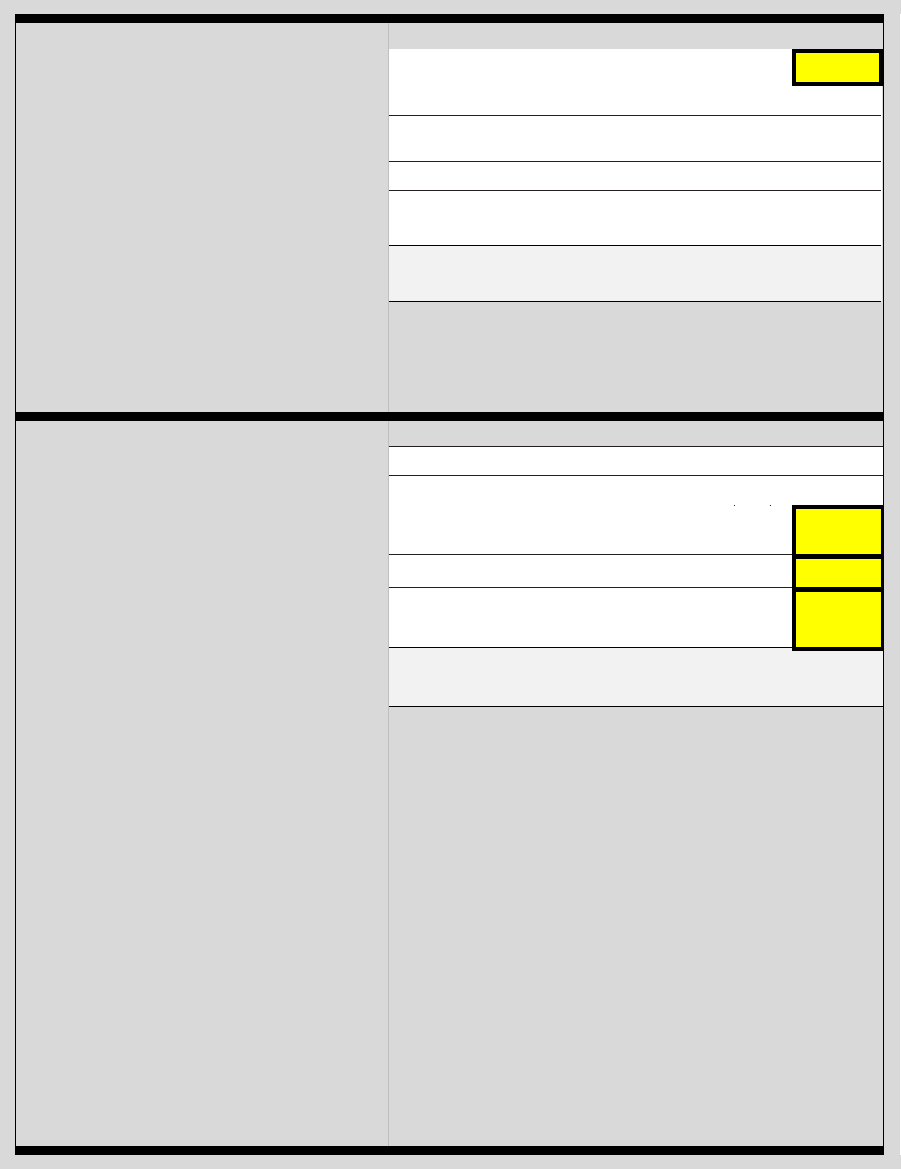
18 DEBT COLLECTION RULE: DISCLOSING THE VALIDATION INFORMATION VERSION 1.0 (10/2021)
ITEMIZATION TABLE
Step 2: Determine the amount
of the debt as of the
itemization date.
Enter the amount of the debt as of
the itemization date selected in
Step 1 (August 5, 2022).
ABC Financial, Inc., discloses the
total outstanding debt, as permitted
by the Rule.
As of August 5, 2022, you owed:
$
75,234.56
Between August 5, 2022 and today:
You were charged this amount in
interest:
+
$
You were charged this amount in fees: +
$
You paid or were credited this
amount toward the debt:
–
$
Total amount of the debt now:
$
Step 3: Determine the Itemized
Amounts since the itemization
date.
Enter the interest and fees charged,
as well as the payments and credits
applied, to the account during the
Itemization Period (i.e., between
the itemization date (August 5,
2022) and the date the validation
information is provided (September
6, 2022)).
Interest: $260 for the
Itemization Period.
Fees: $75 for the Itemization
Period. $25 in late fees and
$50 in property inspection fees.
Payments and Credits: No
payments were made and no
credits were applied during the
As of August 5, 2022, you owed:
$
75,234.56
Between August 5, 2022 and today:
You were charged this amount in
interest:
+
$
260.00
You were charged this amount in fees: +
$
75
.00
You paid or were credited this
amount toward the debt:
–
$
0
Total amount of the debt now:
$
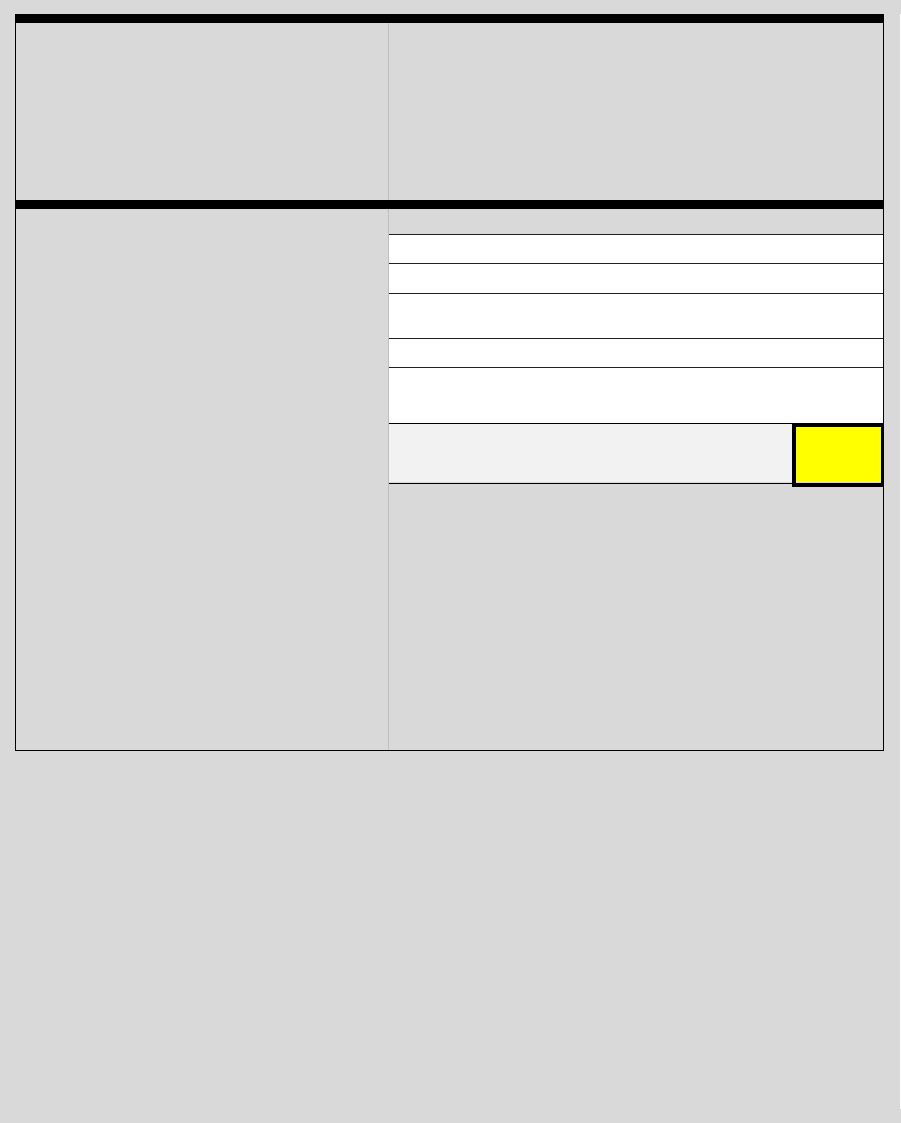
19 DEBT COLLECTION RULE: DISCLOSING THE VALIDATION INFORMATION VERSION 1.0 (10/2021)
ITEMIZATION TABLE
Itemization Period. This field
must still be disclosed. In this
example, the field is disclosed
as “0,” as permitted by the Rule.
Step 4: Determine the current
debt amount.
Enter the amount of the debt as of
the date the validation information
is provided (September 6, 2022).
ABC Financial, Inc., discloses the
total balance of the outstanding
mortgage, including principal,
interest, fees, and other charges, as
permitted by the Rule.
This is the completed Itemization
Table ABC Financial, Inc., included
in the validation notice.
As of August 5, 2022, you owed:
$
74,234.56
Between August 5, 2022 and today:
You were charged this amount in
interest:
+
$
260
.00
You were charged this amount in fees: +
$
75
.00
You paid or were credited this
amount toward the debt:
–
$
0
Total amount of the debt now:
$
74,569
.56
Option 2: Use the Special Rule for Certain Residential Mortgage Debt
Based on these facts, ABC Financial, Inc., would provide, in the same
communication with the validation notice, a copy of the most recent periodic
statement required by Regulation Z, 12 CFR 1026.41. When doing so, ABC
Financial, Inc., could disclose the Itemization Table by applying the four steps
discussed above as follows:
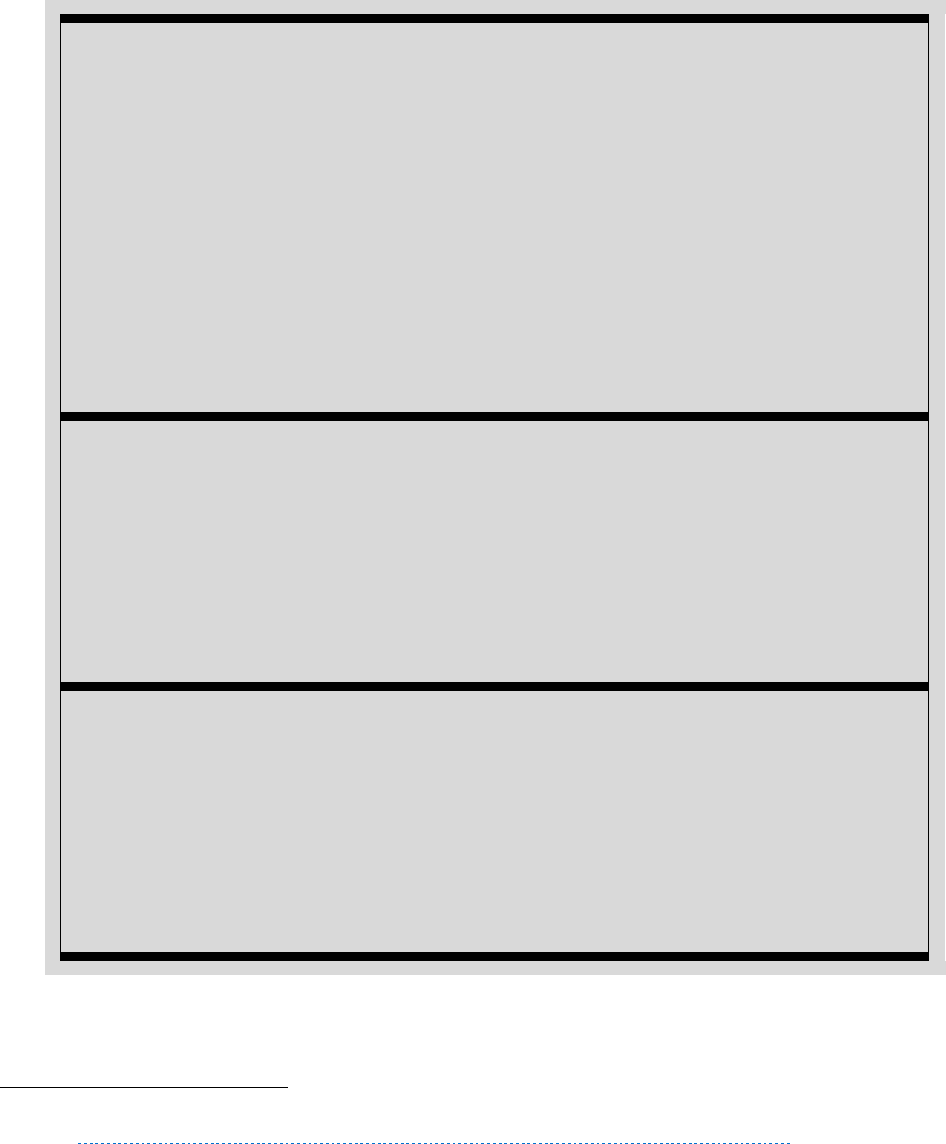
20 DEBT COLLECTION RULE: DISCLOSING THE VALIDATION INFORMATION VERSION 1.0 (10/2021)
ITEMIZATION TABLE
Step 1: Select an itemization date.
Because ABC Financial, Inc., is using the special rule for certain residential mortgage
debt
11
, ABC Financial, Inc., need not disclose an itemization date on the validation
notice. However, ABC Financial, Inc., still needs to determine an itemization date to
disclose the other itemization date-dependent validation information.
Under the special rule for certain residential mortgage debt, ABC Financial, Inc., uses
the date of the most recent periodic statement provided under Regulation Z
(September 5, 2022) as the itemization date, even though that periodic statement was
provided by a debt collector who was not also a creditor.
Step 2: Determine the amount of the debt as of the itemization date.
ABC Financial, Inc., need not determine or disclose this amount on the validation
notice.
Instead, ABC Financial, Inc., discloses a statement on the validation notice referring
the consumer to the enclosed periodic statement. 12 CFR 1006.34(c)(5)(ii).
Step 3: Determine the Itemized Amounts since the itemization date.
ABC Financial, Inc., need not determine or disclose this itemization on the validation
notice.
Instead, ABC Financial, Inc., discloses a statement on the validation notice referring
the consumer to the enclosed periodic statement. 12 CFR 1006.34(c)(5)(ii).
11
See the Debt Collection Rule FAQs, Validation Information: Residential Mortgage Debt Questions and footnotes 3, 4,
and 7 above for more information on the special rule for certain residential mortgage debt. 12 CFR 1006.34(c)(5).

21 DEBT COLLECTION RULE: DISCLOSING THE VALIDATION INFORMATION VERSION 1.0 (10/2021)
ITEMIZATION TABLE
Step 4: Determine the current
debt amount.
Enter the amount of the debt as of
the date the validation information
is provided (September 6, 2022).
ABC Financial, Inc., discloses the
total balance of the outstanding
mortgage, including principal,
interest, fees, and other charges, as
permitted by the Rule.
This is the completed Itemization
Table ABC Financial, Inc., included
in the validation notice.
See the enclosed periodic statement for an itemization
of the debt.
Total amount of the debt now:
$
74,569
.56
Example 3: Medical debt
ABC Financial, Inc., a debt collector, is collecting on a past-due consolidated medical debt
for multiple procedures related to a consumer’s week-long hospital stay. For this debt,
assume the following timeline of events:
June 25, 2021 - July 2, 2021: The consumer was admitted to Regional
Hospital for a week. The consumer was admitted on June 25, 2021, and had
multiple procedures over the week, including on June 26
th
, June 28
th
, July 1
st,
and
July 2
nd
. On July 2, 2021, the consumer was discharged.
August 15, 2021: The consumer was seen for a follow-up appointment related to
the prior hospital procedure. As of August 15
th
, the total medical debt was
$40,000.
September 1, 2021: The consumer’s health insurance required an adjustment of
$3,000 of the amount charged for a procedure.
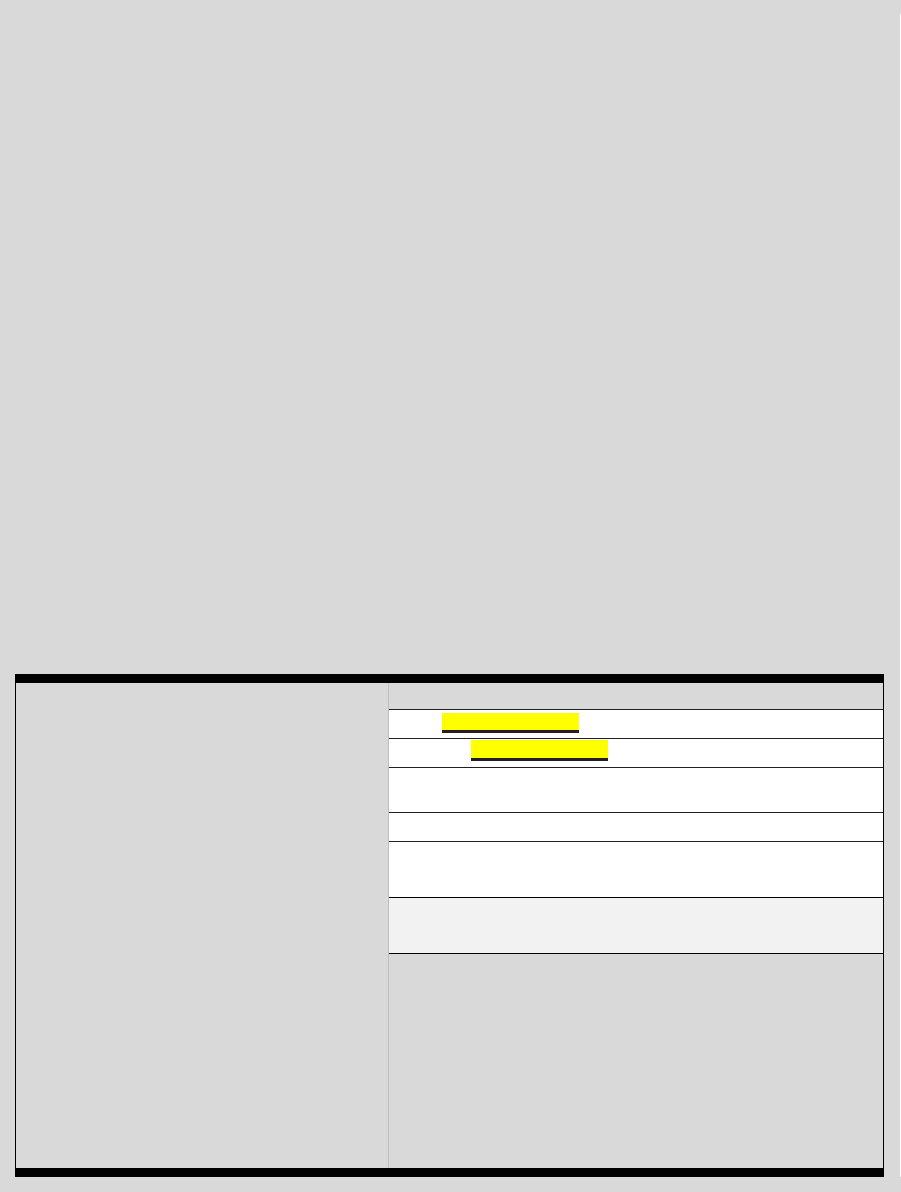
22 DEBT COLLECTION RULE: DISCLOSING THE VALIDATION INFORMATION VERSION 1.0 (10/2021)
ITEMIZATION TABLE
October 1, 2021 - December 1, 2021: The consumer’s health insurance
company made several payments totaling $30,000, the last of which was applied
to the account on December 1
st
. The insurance company notified the consumer
and the hospital that the consumer was responsible for the remainder of the debt.
January 1, 2022 - May 5, 2022: Regional Hospital sent account statements to
the consumer. On May 5
th
, Regional Hospital sent a final invoice to the consumer
stating the outstanding balance.
June 1, 2022: Because the account was in default, Regional Hospital charged off
the debt.
August 1, 2022: Regional Hospital placed the debt with ABC Financial, Inc., a
debt collector, for collection.
September 15, 2022: ABC Financial, Inc., provided the validation notice.
Also assume that, since the date of the last procedure (August 15, 2021), the account did
not accumulate any interest or fees.
Based on these facts, ABC Financial, Inc., could disclose the Itemization Table by
applying the four steps discussed above as follows:
Step 1: Select an itemization
date.
This example uses a transaction
date (August 15, 2021). This is the
date of the last appointment related
to the hospital procedure for the
debt.
Other available reference dates in
this example include:
Transaction date: Alternative
transaction dates for this fact
pattern may include June 25,
As of August 15, 2021, you owed:
$
Between August 15, 2021 and today:
You were charged this amount in
interest:
+
$
You were charged this amount in fees: +
$
You paid or were credited this
amount toward the debt:
–
$
Total amount of the debt now:
$
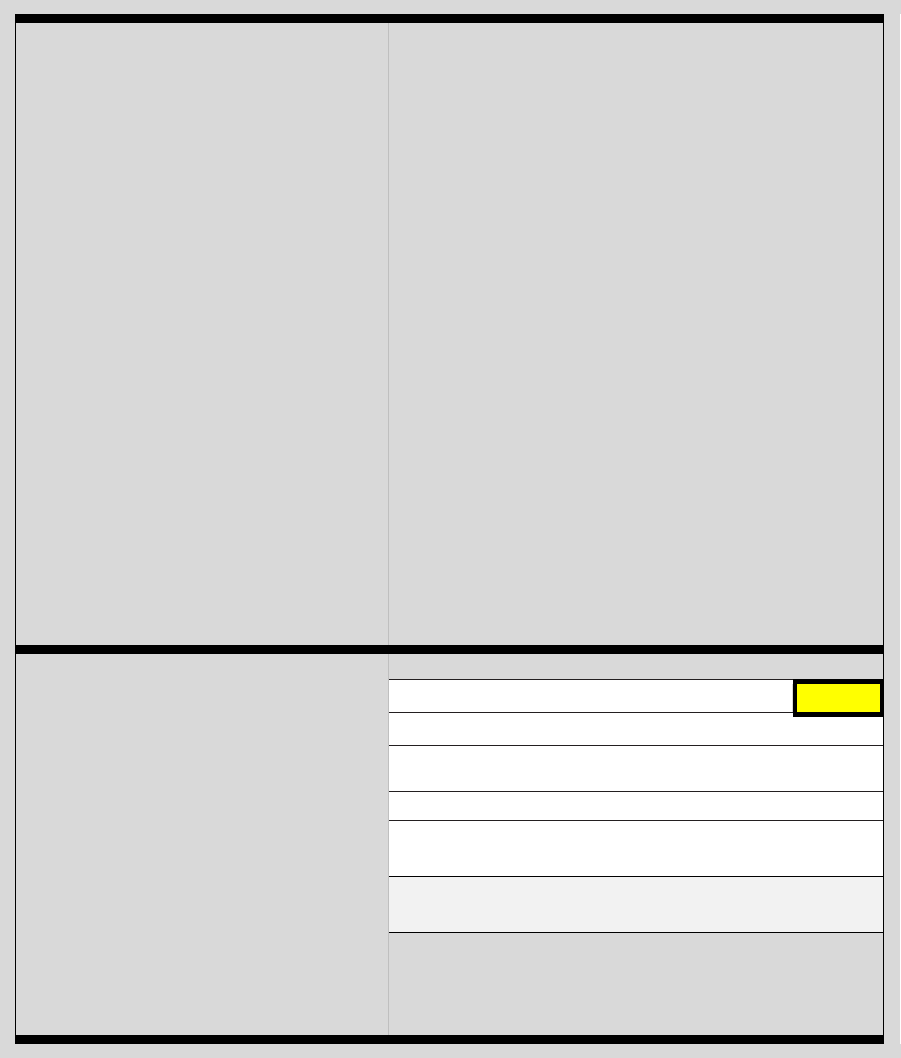
23 DEBT COLLECTION RULE: DISCLOSING THE VALIDATION INFORMATION VERSION 1.0 (10/2021)
ITEMIZATION TABLE
2021 (date of admission); June
26, June 28, July 1, or July 2,
2021 (dates of procedures); or
July 2, 2021 (date of discharge).
Last payment date: December
1, 2021, the date the last
payment was applied to the
account. This payment was
made by the insurance
company.
Last statement date: May 5,
2022, the date of the last
statement sent by the creditor.
Charge-off date: June 1, 2022.
Note: In this example, there is no
judgment date.
Step 2: Determine the amount
of the debt as of the
itemization date.
Enter the account balance as of the
itemization date selected in Step 1
(August 15, 2021).
As of August 15, 2021, you owed:
$
40,000.00
Between August 15, 2021 and today:
You were charged this amount in
interest:
+
$
You were charged this amount in fees: +
$
You paid or were credited this
amount toward the debt:
–
$
Total amount of the debt now:
$

24 DEBT COLLECTION RULE: DISCLOSING THE VALIDATION INFORMATION VERSION 1.0 (10/2021)
ITEMIZATION TABLE
Step 3: Determine the Itemized
Amounts since the itemization
date.
Enter the interest and fees charged,
as well as the payments and credits
applied, to the account during the
Itemization Period (i.e., between
the itemization date (August 15,
2021) and the date the validation
information is provided (September
15, 2022)).
Interest: No interest was
charged during the Itemization
Period. This field must still be
disclosed. In this example, the
field is disclosed as “0,” as
permitted by the Rule.
Fees: No fees were charged
during the Itemization Period.
This field must still be
disclosed. In this example, the
field is disclosed as “0,” as
permitted by the Rule.
Payments and Credits:
$33,000 for the Itemization
Period. The health insurance
company made $30,000 in
payments. Additionally, an
insurance adjustment of
$3,000 occurred during this
time period.
As of August 15, 2021, you owed:
$
40,000.00
Between August 15, 2021 and today:
You were charged this amount in
interest:
+
$
0
You were charged this amount in fees: +
$
0
You paid or were credited this
amount toward the debt:
–
$
33,000.0
0
Total amount of the debt now:
$
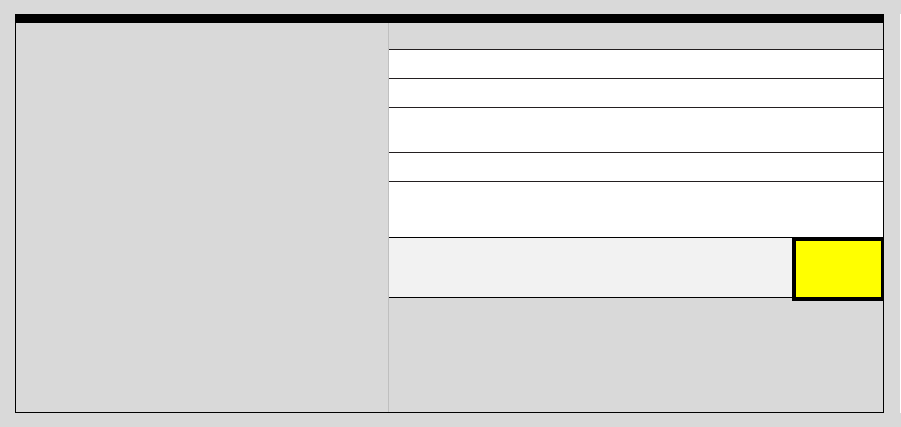
25 DEBT COLLECTION RULE: DISCLOSING THE VALIDATION INFORMATION VERSION 1.0 (10/2021)
ITEMIZATION TABLE
Step 4: Determine the current
debt amount.
Enter the current account balance
as of the date the validation
information is provided (September
15, 2022).
This is the completed Itemization
Table ABC Financial, Inc., included
in the validation notice.
As of August 15, 2021, you owed:
$
40,000.00
Between August 15, 2021 and today:
You were charged this amount in
interest:
+
$
0
You were charged this amount in fees: +
$
0
You paid or were credited this
amount toward the debt:
–
$
33,000.0
0
Total amount of the debt now:
$
7,000
.00
Multiple Debts
A debt collector who is collecting multiple debts owed or alleged to be owed by the same consumer
may provide 1) a separate validation notice for each debt, or 2) depending on the facts and
circumstances, a single validation notice that combines some or all of the debts.
As stated above, this guidance document assumes use of the model validation notice, and, as such,
use of the Itemization Table, to obtain a safe harbor for the Rule’s validation information content
and format requirements. A debt collector could receive that safe harbor when disclosing multiple
debts on a single validation notice where 1) the debts are owed or alleged to be owed by the same
consumer, 2) the debts are owed to the same creditor, and 3) the debts have a common itemization
date.
A debt collector disclosing multiple debts would not obtain the validation information content and
format requirements safe harbor for use of the model validation notice if it included multiple
Itemization Tables on the model validation notice itself.
However, a debt collector disclosing multiple debts on a single model validation notice to obtain
that safe harbor may do one of the following:
1. Include a cumulative itemization of the Itemized Amounts in the Itemization Table on the
model validation notice, reflecting the required information for all of the relevant debts in one
table; or
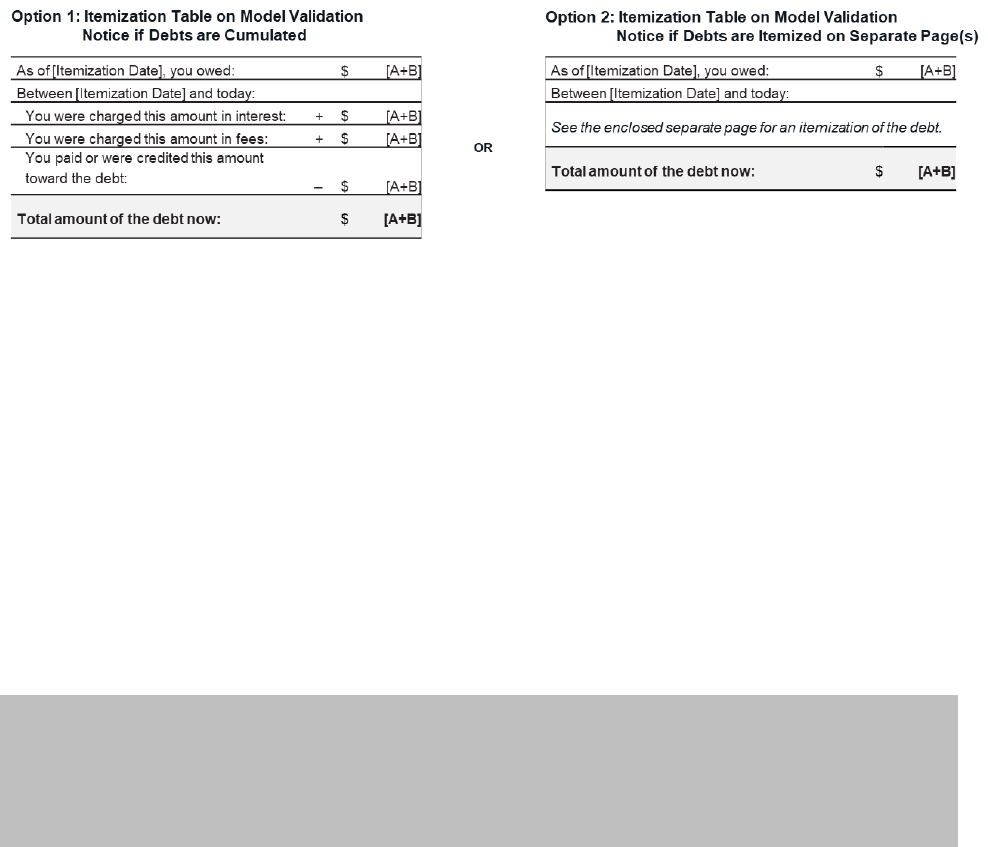
26 DEBT COLLECTION RULE: DISCLOSING THE VALIDATION INFORMATION VERSION 1.0 (10/2021)
ITEMIZATION TABLE
2. Include an Itemization Table on the model validation notice with a statement referencing
separate page(s) where the Itemized Amounts are disclosed. The debt collector would include
a separate itemization of each debt on one or more pages in the same communication with the
model validation notice. Comment 1006.34(c)(2)(viii)-4.
An illustration of how a debt collector may complete the Itemization Table on the model validation
notice for each of these options is shown in Figure 6.
FIGURE 6: EXAMPLE OF COMPLIANT ITEMIZATION TABLES FOR MULTIPLE DEBTS
A debt collector who chooses to obtain the safe harbor for validation information content and
format requirements by using the model validation notice would be compliant if it disclosed
multiple debts in a single, cumulative format on the model validation notice following the steps in
this guidance document to produce an Itemization Table like the table shown in Option 1 in the
figure above.
In doing so, the debt collector would, in Step 1, select and provide one itemization date, a date that
is the same for each debt. For Step 2, for multiple debts disclosed this way, the amount of the debt
as of the itemization date is the sum of the amount of the debts as of that date. For Step 3, the
debt collector would provide the Itemized Amounts in a single, cumulative itemization, with a
cumulative sum for each field. For Step 4, the current amount of the debt is a single, cumulative
figure that would be the sum of all the debts. Comment 1006.34(c)(2)(ix)-2.
Example: Single Validation Notice with Cumulative Itemization Table
Assume that a debt collector is collecting a consumer’s three medical debts that include a
hospital stay debt, radiology services debt, and physical therapy services debt. These debts are
all from the same creditor. The debt collector chooses to combine the three debts in a single

27 DEBT COLLECTION RULE: DISCLOSING THE VALIDATION INFORMATION VERSION 1.0 (10/2021)
ITEMIZATION TABLE
validation notice and chooses to provide a cumulative Itemization Table. Using the process
discussed above, the debt collector would do the following:
Step 1: Select one itemization date that applies for all the debts.
Step 2: Using that date, determine the amount of each of the debts as of that itemization date
and disclose the cumulative sum of those amounts.
Step 3: Calculate any Itemized Amounts that have accrued during the Itemization Period for all
three debts and disclose each of the applicable fields of the Itemization Table with the relevant
cumulative sums.
Step 4: Finally, sum the current amount of debt for all three debts.
A debt collector who chooses to obtain the safe harbor for validation information content and
format requirements by using the model validation notice would also be compliant if it disclosed
multiple debts by providing separate itemizations for each debt on a separate page(s) in the same
communication as the validation notice. The debt collector would still be required to disclose the
Itemization Table on the validation notice, and could disclose the table as shown in Option 2 in
Figure 6.
As shown in that table, the debt collector would be compliant if it disclosed a single itemization
date for Step 1, one cumulative amount of the debt as of that date for Step 2, and a cumulative
current debt amount for Step 4. However, for Step 3, the debt collector must include in the
Itemization Table a reference to the separate page(s) and then provide the separate itemizations
on a separate page or pages. Comment 1006.34(c)(2)(viii)-4.
12
Nothing in the Rule prohibits a
debt collector from repeating the information in Steps 1, 2, or 4 on the separate page(s) with the
Itemized Amounts from Step 3.
12
As noted in footnote 8, a debt collector may provide the itemization of the current amount of the debt on a separate
page(s). Comment 1006.34(c)(2)(viii)-4; Comment 1006.34(c)(2)(viii)-3. However, the debt collector does not
receive a safe harbor for the content and format requirements for any information included on the separate page(s).
12 CFR 1006.34(d)(2)(ii).
